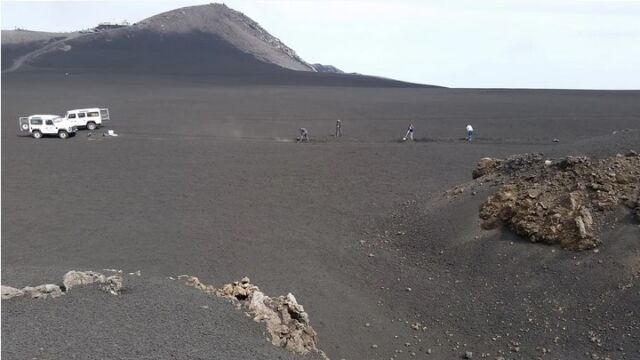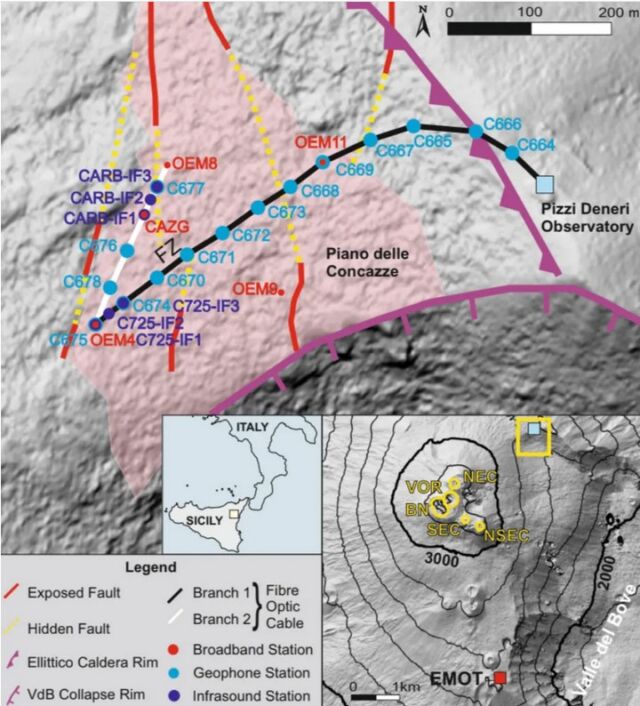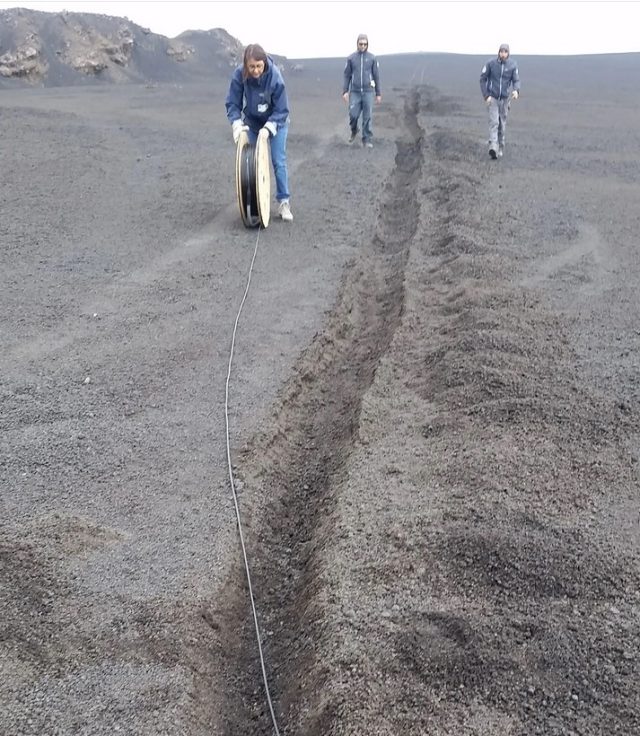Specialists distinguish volcanic action by seeing how light travels through a link.

Transcending 11,000 feet over 1,000,000 people, Mount Etna is one of the most completely observed volcanoes on Earth.
Many sensors speck its flanks, and for good explanation: it's Europe's most dynamic fountain of liquid magma,
intermittently regurgitating magma and tremendous crest of flotsam and jetsam that ground planes and by and large cause problems for those living in its shadow.
In any case, presently researchers have been keeping an eye on Etna with a far-fetched new reconnaissance gadget: fiber-optic links, similar to the ones that present to you the Internet.
Composing last week in the diary Nature Communications, specialists portrayed how they utilized a procedure known as appropriated acoustic detecting, or DAS, to get seismic signs that traditional sensors missed.
This could assist with further developing the early admonition framework that individuals in the encompassing pieces of Italy depend on.
Millions more all over the planet are additionally helpless before dynamic volcanoes, which make confusion whether they are enormous or little.
DAS is stirring up (sorry) science incredibly. At the point when the Internet was filling during the 1990s, telecoms wound up setting down more fiber-optic link than they required, since the actual material was modest contrasted with the work expected to cover it.
That additional link stays unused, or "dull," and researchers can lease it out to run DAS tests.
Engineers use it to screen land disfigurement, geophysicists use it to concentrate on seismic tremors, and scientists are in any event, utilizing submerged links to get the vibrations of whale calls.

Fiber optics work by shipping signals from point A to point B as beats of light.
In any case, assuming the link is upset by, say, a seismic tremor, a minuscule measure of that light gets quickly returned to the source.
To quantify this, researchers utilize an "investigative specialist," which fires a laser through the filaments and breaks down what returns.
Since specialists know the speed of light, they can decide unsettling influences at different lengths along the link: something happening 60 feet away will quickly return light that takes somewhat longer to get to the cross examiner than something occurring at 50 feet.
These estimations are delicate.
For instance, in the spring of 2020, during the beginning of COVID-19 lockdowns, researchers at Pennsylvania State University utilized their grounds' covered dull fiber optics to see as common and vehicle development disappeared and got once more.
They actually might tell the wellspring of the over-the-ground unsettling influence by the recurrence of its vibration: a human stride is somewhere in the range of 1 and 5 hertz, though vehicle traffic is 40 to 50 hertz.
This new examination fixates on similar thought, just these researchers did it on a functioning fountain of liquid magma.
Since telecoms never tried to lay fiber optics on Mount Etna, the specialists dug a three-quarter-mile-long trench under a foot down and covered their own, not a long way from the fountain of liquid magma's edge.

In the picture above, you can perceive how the fiber-optic link was arranged, its two branches illustrated in white and dark.
(The red and yellow lines are shortcomings.) The specks running along the link lines are places where the researchers had traditional sensors,
similar to seismometers, which use pendulums to distinguish development, and geophones, which convert ground development into electrical signs.
Since these sensors and the link were colocated at those spots — at C666, C667, etc — the specialists could think about how the various procedures were observing movement.

The picture above demonstrates what a volcanic blast (not an all out emission) in September 2018 looked like to the DAS organization.
The detecting stations are noted at the highest point of the realistic. The red and blue address the disfigurement, or "strain rate" at which the link lengthens or contracts, at a given time for each six feet along the length of the link.
"So on the off chance that the actual link is, suppose, broadened or compacted, we see that in the signs," says Charlotte Krawczyk, a geoscientist at German Research Center for Geosciences and Technical University Berlin,
co-creator of the paper portraying the work. "With any remaining seismic hardware, we don't do that. We measure the speed increase of the surface or that's what things like."
Notice the more obscure vertical red and blue band at C671, which is an expansion in the sign's plentifulness.
Assuming you glance back at the guide, you'll see that C671 is sitting right on a shortcoming. "Here the thickness and the speed of the ground is unique," says geoscientist Philippe Jousset of the German Research Center for Geosciences, lead creator of the paper.
That changes how the energy swells through the earth and along these lines how the DAS peruses the occasion.
The link distinguished other volcanic happenings, also, which the traditional sensors either missed or scarcely perceived.
It discovered degassing occasions, in which the fountain of liquid magma delivers a crest of water fume and different gases like carbon dioxide.
Individuals on Etna at the time really recorded video of this — ground-truthing at its best.
DAS additionally recorded "single quake beats," which were unmistakable from degassing because of the lower recurrence of their sign. (Contemplate how vehicles and people on foot were unmistakable in the Penn State study.)
The specialists figure these heartbeats could be the development of gas or fluid at profundity, which thusly drives degassing occasions.


.jpg)







0 Comments
Write a comment if you liked the topic